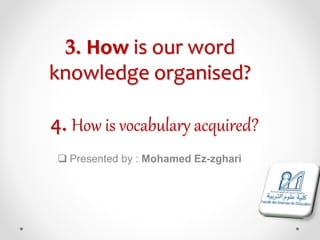
How are words organised in our minds? how is vocabulary learnbed?
- 1. 3. How is our word knowledge organised? 4. How is vocabulary acquired? Presented by : Mohamed Ez-zghari
- 2. How is our word knowledge organised? • The way words are stored in the mind resembles less a dictionary than a kind of network or web . . . . The mind seems to store words neither randomly nor in the form of a list, but in a highly organized interconnected fashion— the mental lexicon.
- 3. Sometimes, we want to say a word, but we end up saying another one. Why?
- 4. • Words are organized in the mind according to categories: fruits, clothes, animals…and once we have access to a word in a category, this word allows us to know other words within the same category.
- 5. • The mental lexicon organizes words by double entries—Meaning & form. These entries are linked to other words that share the same characteristics. Meaning: ( manga/ papaya) Form: ( tangi/ tango) • It is more that. When you activate a word, it activates with it general knowledge and experience because every body has a different representation of the word meaning in his brain and different experiences related to that word, differently from others.
- 6. • Knowing a word is a sum total of all these connections— semantic, syntactic, phonological, morphological, cognitive, and cultural
- 7. How is vocabulary acquired? • The difference between how children acquire vocabulary in their first language and adult in learning a second language
- 8. • In learning their first language, the first words that children learn are those used for labelling—that is mapping words into concepts ; for example, the concept “dog” has a name ‘dog’ or ‘doggie’. • Then, the child has to learn how to classify the words he/she learns into categories ( fruit, animal…)
- 9. • How is building vocabulary in first language different form that of second language?
- 10. • Adult learners already have a language. They already have a conceptual system that links words to what they refer to. • Learning a second language, they need to make a new conceptual system and vocabulary network. adult learners have a privilege that they already know “ things” in their fist language, so they resort to it.
- 11. • yet this practice might become a matter of confusion and errors. • Some words might be thought of to have the same equivalents in the Target language, but sometimes they don’t.( actually, chef—in French—do not mean the same in English )
- 12. • words having the same equivalents in the target language: (table in French & English) Real friends • words having different equivalents in the target language: ( traduction in French/ translation in English) False friends • words having no equivalents in the target language: supposedly ( privacy, community have no equivalents in Chinese) Strangers
- 13. Thank you